Japanese Dishes You Have to Try at Least Once
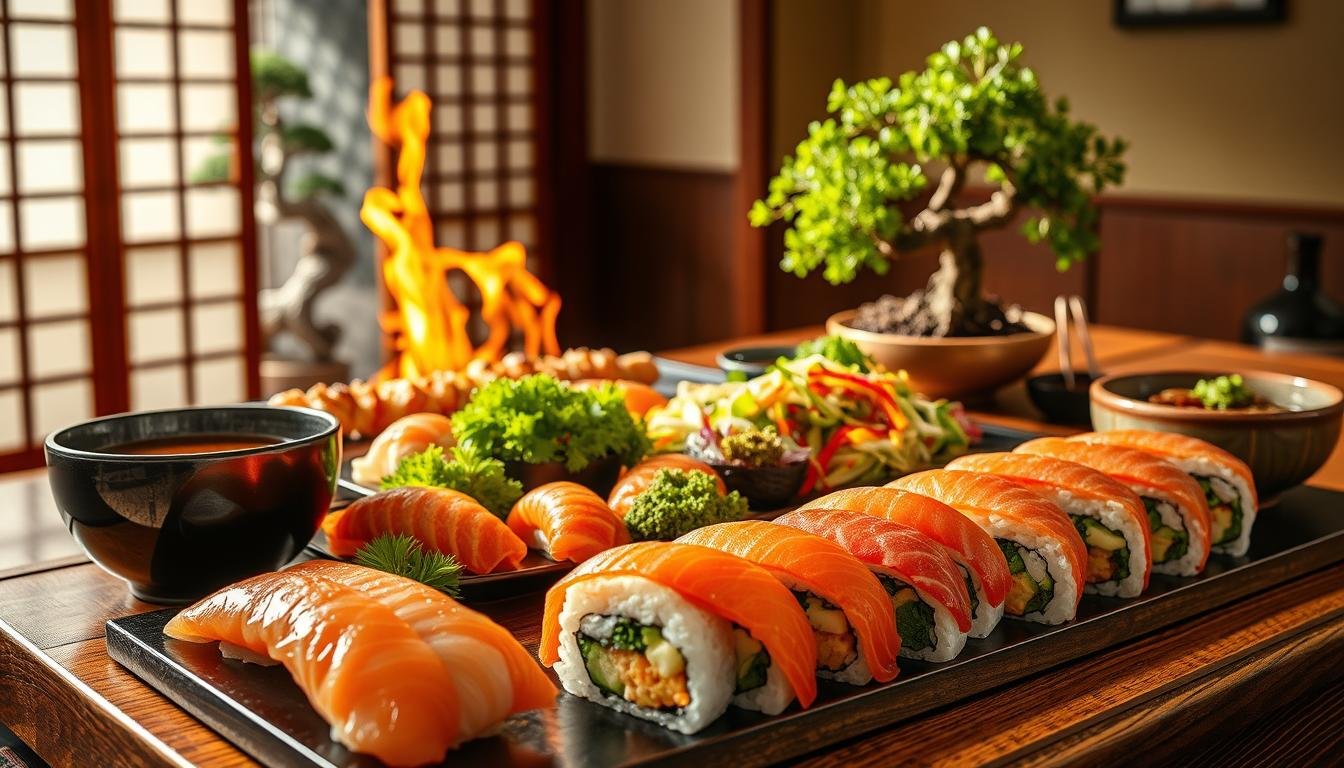
Exploring new flavors is magical, right? I’ll never forget my first sushi bite with soy sauce—it was pure joy! Japanese cuisine pulls you in with both traditional meals and comfy foods. These meals have been perfected over hundreds of years. They promise a world of amazing tastes.
For both food lovers and beginners, Japanese dishes are essential! They’re bursting with flavors and good for your health. Imagine enjoying delicious seafood that’s both tasty and healthy for you.
Key Takeaways
- Japanese cuisine is celebrated for its variety, health benefits, and culinary artistry.
- Traditional Japanese dishes range from simple meals to high-dining treats.
- Japanese comfort food offers warmth and satisfaction.
- Delicious Japanese seafood dishes are both nutritious and flavorful.
- Experiencing Japanese cuisine can be a memorable and joyous adventure.
An Introduction to Japanese Cuisine
Japanese cuisine, known as washoku, is a beautiful blend of harmony, seasonal freshness, and visual beauty. Every dish is crafted to not just taste amazing but also to be healthy. This makes it great for those looking for easy Japanese meals. Let’s explore what makes this cuisine stand out and how it supports a healthy lifestyle.
The Philosophy Behind Japanese Cooking
Japanese cooking follows a philosophy that values harmony with nature and its seasons. Using fresh, seasonal ingredients is key. This ensures each meal is full of seasonal flavors. This approach shines in healthy Japanese dishes with lots of vegetables, seafood, and grains.
From choosing the ingredients to the way they’re prepared, everything aims to create a meal that’s both balanced and nutritious.
Key Ingredients in Japanese Dishes
There are several ingredients that are central to many Japanese dishes, each adding its own taste and texture:
| Ingredient | Description | Uses |
|---|---|---|
| Seafood | A staple in Japanese cuisine, often sourced fresh from local waters. | Sushi, sashimi, tempura |
| Rice | A versatile ingredient, forming the base of many dishes. | Sushi, donburi, onigiri |
| Seaweed | Rich in umami, providing a depth of flavor to soups and salads. | Miso soup, sushi rolls, salads |
| Soy Products | Includes tofu, natto, and soy sauce, integral to Japanese cooking. | Sauces, soups, vegetarian dishes |
Whether you’re making a big dinner or simple Japanese meals, these ingredients are key. Japanese cuisine is admired for its simplicity and natural taste. It’s great for making *healthy Japanese dishes* and wonderful Japanese vegetarian dishes.
Sushi: A Timeless Classic
Sushi started as simple street food in Japan but has become a global favorite. It mixes vinegared rice with fresh seafood, veggies, and sometimes fruits. This blend makes sushi a worldwide delight due to its simple yet complex flavors.
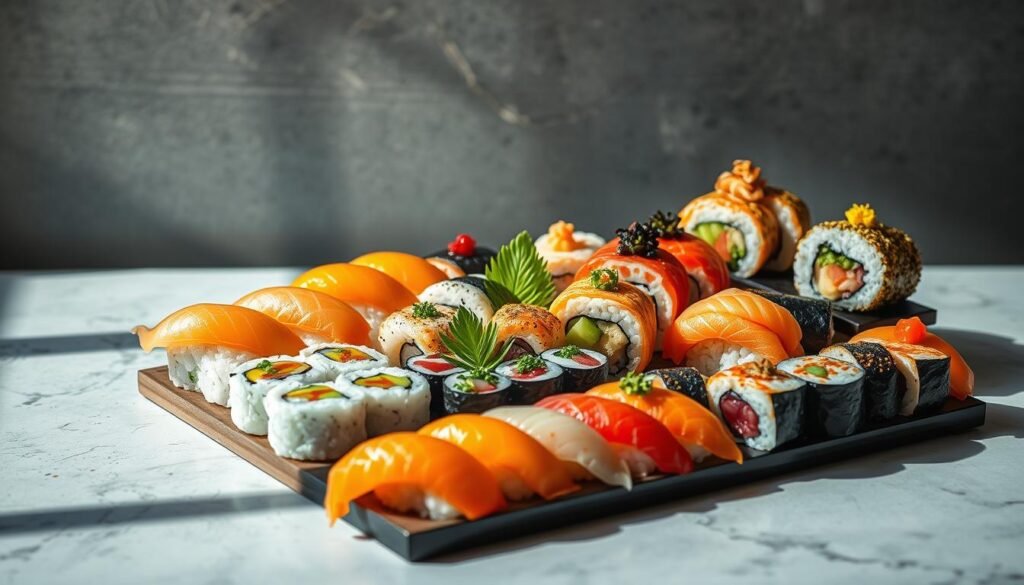
Different Types of Sushi
There are many types of sushi, each with its own taste and look. Nigiri consists of fish on rice. Maki rolls are filled with various ingredients and rolled in seaweed. Sashimi, different from sushi, is just raw fish without rice. These options make sushi a versatile choice for any meal.
How Sushi is Made
Making sushi is simpler than you might think. It all starts with preparing the sushi rice just right, using vinegar, sugar, and salt. Then, you add fresh fish, veggies, or fruit. Rolling or shaping these with the rice can be fun, whether at home or at a sushi bar.
Best Sushi Restaurants in America
In the U.S., some places serve amazing Japanese sushi. Sushi Nakazawa in New York offers a special omakase experience. Nobu in Los Angeles mixes Japanese and Peruvian styles. Masa in New York serves luxurious sushi made with top ingredients. These spots are the best for exploring sushi’s finest.
Ramen: More Than Just Noodles
Ramen is not just a simple noodle dish. It’s a blend of savory broth, tender noodles, and various toppings. Each bite offers a unique experience. Let’s explore the exciting world of ramen, its beginnings, popular types, and where to find it in America!
Origins of Ramen
Ramen started in China but became a hit in Japan. It arrived in the late 19th century. Japanese chefs made it their own, crafting recipes that are cherished today. Nowadays, you can find ramen in simple home kitchens and fancy eateries.
Popular Ramen Styles
Ramen comes in many flavors, each from different regions. Here are some top ramen styles:
| Style | Broth Base | Region | Key Characteristics |
|---|---|---|---|
| Tonkotsu | Pork Bone | Fukuoka | Rich and creamy |
| Miso | Fermented Soybean Paste | Hokkaido | Flavorsome and hearty |
| Shoyu | Soy Sauce | Tokyo | Clear and oily |
| Shio | Salt | Hakodate | Light and clear |
Where to Find Authentic Ramen
Want real ramen without going to Japan? You’re in luck. There are many ramen-yas in the U.S. that serve true Japanese flavors. Try places like Ichiran in New York or Ramen Tatsu-ya in Austin for a taste of real ramen!
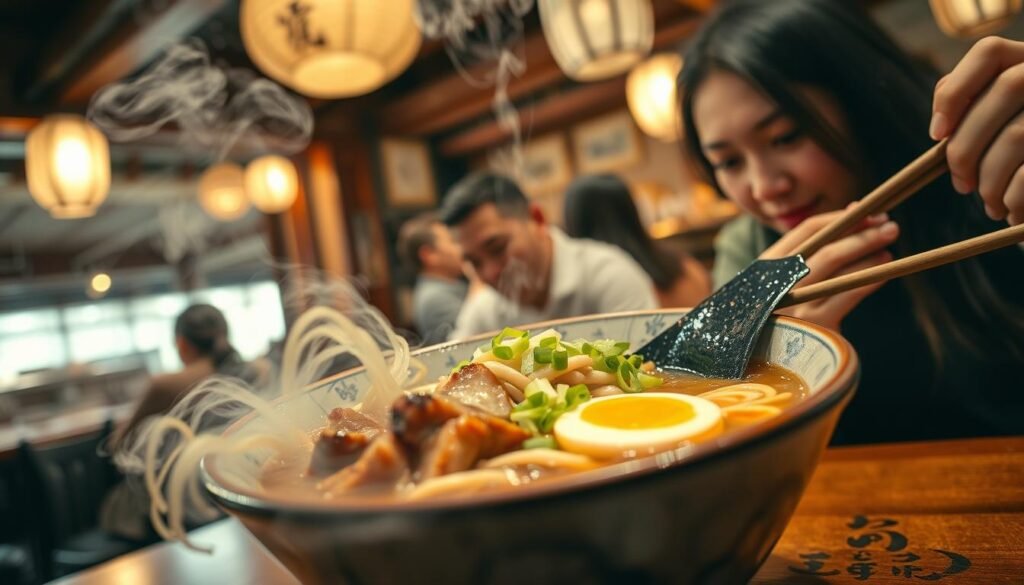
Tempura: The Art of Frying
Tempura came to Japan from Portuguese traders in the 16th century. It is now a key part of Japanese food. Chefs in Japan have made this way of frying food in batter really special. It makes seafood and veggies light and crispy.

What is Tempura?
Tempura is about coating and frying food, mainly seafood and vegetables. The crispy layer makes the flavors shine. It’s a top choice for exploring Japanese veggie dishes and healthy options.
Common Ingredients in Tempura
Tempura can be made with many foods. You’ll see shrimp, squid, eggplant, sweet potatoes, and green beans. Each adds its own taste and texture. From shrimp’s sweetness to sweet potatoes’ earthy taste, tempura has a lot to offer.
Tempura vs. Other Fried Foods
Tempura’s batter is lighter than most Western fried foods. It mixes cold water, flour, and sometimes an egg. This makes tempura crisp but not greasy. It’s a healthier fried choice that highlights the food’s natural flavors.
Sashimi: A Fresh Perspective
In Japanese cuisine, sashimi is a standout dish. It is simple yet sophisticated. Unlike sushi, it mainly features raw fish or meat slices. These slices highlight the fresh flavors and textures.
Understanding Sashimi
Sashimi offers a taste of the freshest fish. Expert chefs cut the fish into thin slices. These slices melt in your mouth. It’s important in Japanese cuisine for its elegance and simplicity.
The Best Fish for Sashimi
The fish quality in sashimi is crucial. Favorites are tuna, salmon, and flounder. Each brings a special taste and feel. They’re served with soy sauce, wasabi, and pickled ginger. These add-ons enhance the sashimi and are great Japanese side dishes for dinner.
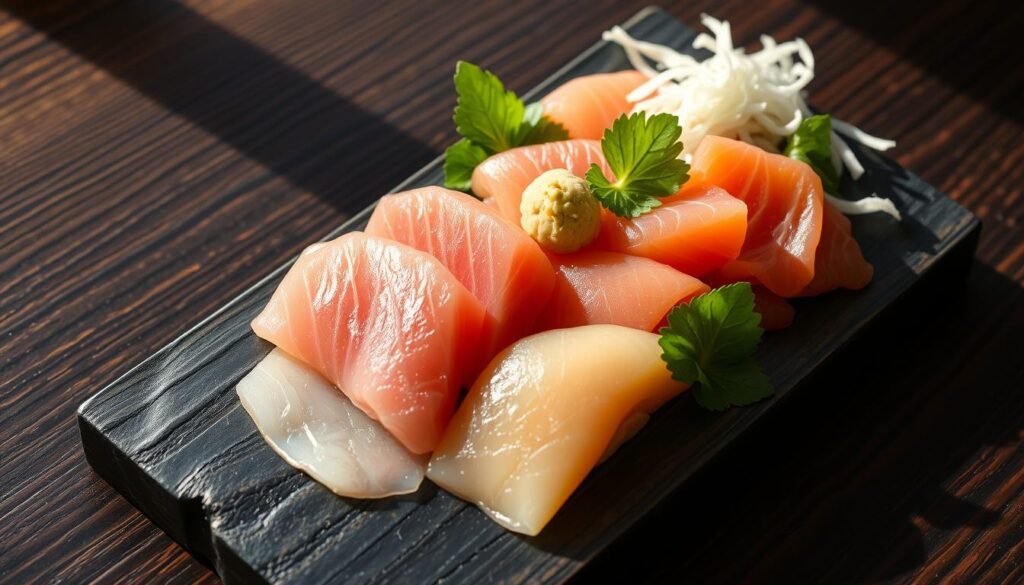
Sashimi Serving Techniques
How sashimi is presented matters a lot. Slices are arranged neatly, often with shiso leaves or daikon radish. This showcases the fish’s beauty. It makes the dish tasty and visually appealing. With some practice, it’s a *quick Japanese dish* that wows guests.
Donburi: A Comfort Food Favorite
Donburi is known as the Japanese rice bowl dish. It is loved for its comfort. You can have it with meat, fish, or vegetables. These are all laid on warm, fluffy rice. It’s a favorite in many homes!
Gyudon, katsudon, and oyakodon are some popular types of donburi. Each one has its own special taste. They turn every meal into an exciting journey!
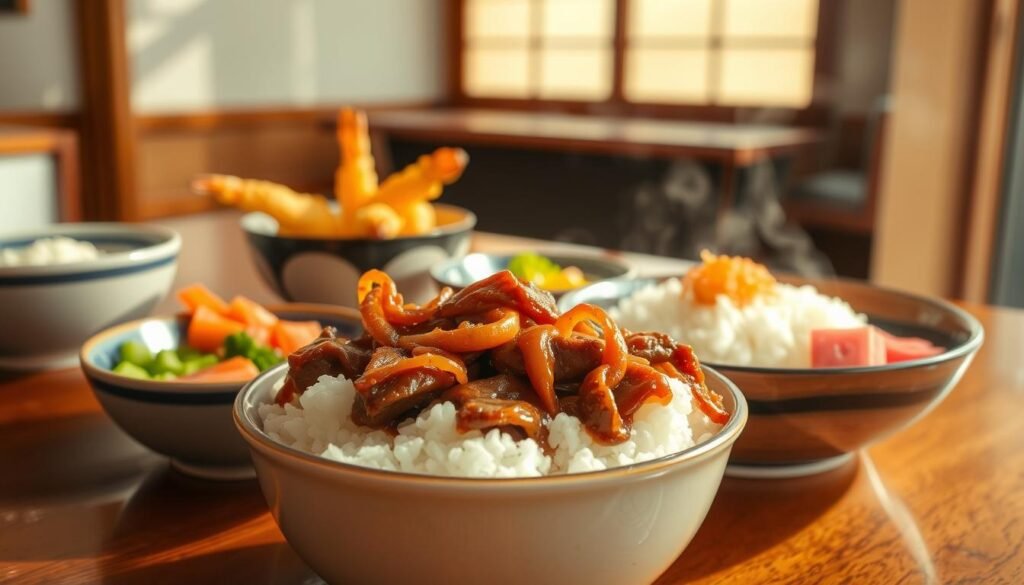
Various Types of Donburi
Donburi can be made in many ways. Gyudon has thinly sliced beef and onions in a tasty sauce. Katsudon is a crispy pork cutlet with rice. It is covered in a delicious sauce.
Oyakodon mixes chicken and eggs. They are cooked until they are just right. It’s a real comfort food.
| Type of Donburi | Main Ingredients | Flavor Profile |
|---|---|---|
| Gyudon | Beef, onions, rice | Savory and sweet |
| Katsudon | Pork cutlet, egg, rice | Crispy and hearty |
| Oyakodon | Chicken, egg, rice | Rich and comforting |
These types show how donburi fits different tastes. Each donburi gives a special eating experience. It’s both exciting and comforting.
How to Make Donburi at Home
Want to try making Japanese dishes? Start with donburi! It’s easy and you can change it up. You just need rice, protein, and some seasonings.
First, cook your rice until it is fluffy. Next, prepare your toppings. This could be beef, pork, chicken, or veggies. Cook them with soy sauce, mirin, and sugar. Then, put your rice in a bowl and add the toppings on top. Now, you have a yummy homemade dish.
Feel free to explore. Try adding a soft-boiled egg or sesame seeds. You can even drizzle more soy sauce on top. Donburi is great for trying new things!
Takoyaki: A Street Food Sensation
If you’ve wandered through a street food market in Japan, you’ve smelled takoyaki. These snacks started in Osaka in the 1930s. They are a beloved Tasty Japanese appetizer that’s hard to resist!
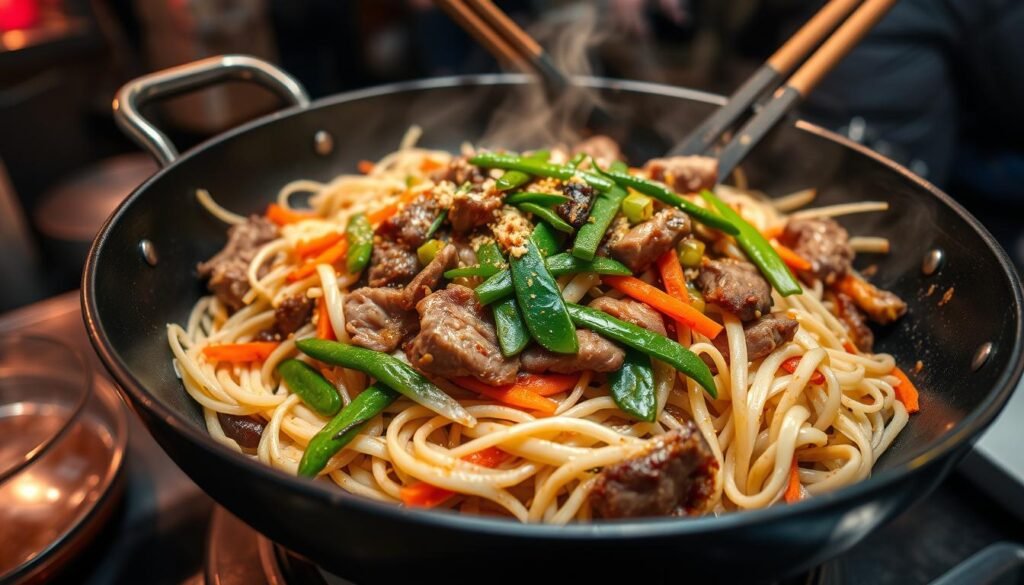
History of Takoyaki
Takoyaki means “octopus grilled/fried,” created by Tomekichi Endo in Osaka. First, these Traditional Japanese appetizers hit yatai (food stalls) at festivals. Now, they’re loved in Japan and worldwide, by many food enthusiasts.
Ingredients and Preparation
Making takoyaki is fun! It’s a mix of flour, eggs, and dashi (savory broth). Then, add octopus, pickled ginger, and green onions. This mix goes into a special pan to cook into round balls. Flipping them requires skill to get them just right.
| Key Ingredient | Description |
|---|---|
| Octopus | Fresh chunks added to the batter, giving takoyaki its signature taste. |
| Pickled Ginger | Provides a zesty flavor that complements the savory batter. |
| Green Onion | Adds a light, refreshing crunch to the takoyaki. |
The Best Places for Takoyaki in the U.S.
Want authentic takoyaki in the U.S.? Look in cities like Los Angeles and New York. They have Japanese stir fry dishes on their food scenes. For real takoyaki, try Mitsuwa Marketplace in California or Dotonbori in New York!
Matcha: The Versatile Green Tea
Matcha is a famous green powder from Japan. It’s not just for tea ceremonies. It’s got many uses, let’s explore them!
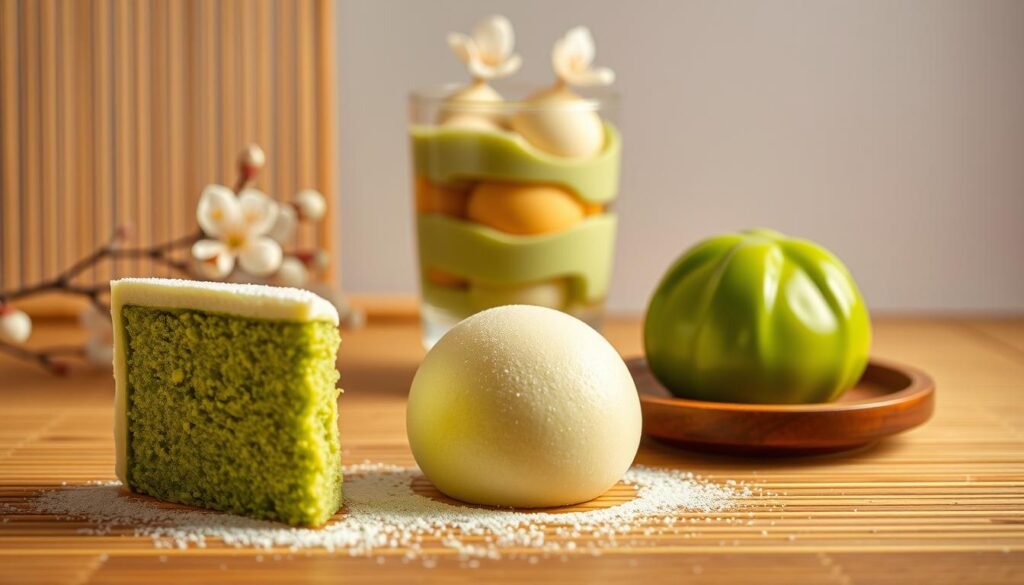
Health Benefits of Matcha
Matcha is known for its great taste and health perks. It’s full of antioxidants, boosts your metabolism, and makes you feel good. It’s perfect for anyone looking to stay healthy!
Matcha in Japanese Desserts
Matcha is popular in desserts too. You can find it in ice cream, cakes, and cookies. Its unique flavor adds a special touch to sweets, making them extra tasty and pretty.
Where to Buy Quality Matcha
Want to try matcha? It’s important to buy high-quality matcha. You can find it at special tea shops or online in the U.S. With the best matcha, you can make traditional tea or try new recipes!
Conclusion: Embrace Japanese Cuisine
Our journey through Japanese cuisine shows it has something special for everyone. Sushi, ramen, and sashimi each tell a unique story. The focus is on the natural flavors and respect for each ingredient.
Final Thoughts on Trying Japanese Dishes
Now is the perfect time to try Japanese cuisine. Start with something simple like miso soup or donburi. These dishes are not only tasty but also easy to make. They will give you a real taste of Japan’s food.
Suggestions for Cooking Japanese at Home
Ready to make Japanese food at home? Begin with meal prep ideas for easy dinners. Try making teriyaki chicken donburi or crispy tempura with rice. Use quality ingredients for the best flavors.
Visit local Asian markets for fresh ingredients. Also, look online for cooking tips and tutorials. Cooking Japanese meals can be fun. It adds joy to your everyday eating.